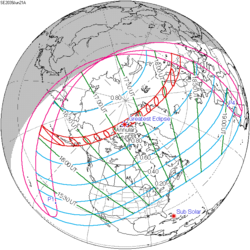| Partial eclipse | |
| Gamma | −1.0411 |
|---|---|
| Magnitude | 0.928 |
| Maximum eclipse | |
| Coordinates | 69°36′S58°18′E / 69.6°S 58.3°E |
| Times (UTC) | |
| Greatest eclipse | 21:45:51 |
| References | |
| Saros | 123 (52 of 70) |
| Catalog # (SE5000) | 9494 |
A partial solar eclipse occurred at the Moon's ascending node of orbit between Saturday, November 13 and Sunday, November 14, 1993, [1] with a magnitude of 0.928. A solar eclipse occurs when the Moon passes between Earth and the Sun, thereby totally or partly obscuring the image of the Sun for a viewer on Earth. A partial solar eclipse occurs in the polar regions of the Earth when the center of the Moon's shadow misses the Earth.
Contents
- Images
- Eclipse details
- Eclipse season
- Related eclipses
- Eclipses in 1993
- Metonic
- Tzolkinex
- Half-Saros
- Tritos
- Solar Saros 123
- Inex
- Triad
- Solar eclipses of 1993–1996
- Saros 123
- Metonic series
- Tritos series
- Inex series
- References
- External links
A partial eclipse was visible at sunrise over parts of Australia on November 14 (Sunday), continued over New Zealand and Antarctica, and ended at sunset over the southern tip of South America on November 13 (Saturday).





































































































